Lida Cardozo Kindersley gave a talk at the Local History Group meeting on 15 November 2018 about the Cardozo Kindersley Workshop, including the history of the Trumpington War Memorial and other local work. We are very grateful to Lida for her excellent presentation and permission to include her additional notes and her slides. Report by Andrew Roberts.
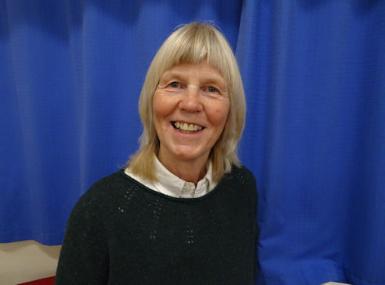
In introducing Lida Cardozo Kindersley, Howard Slatter said that Lida joined David Kindersley in his Workshop in 1976 and they married 10 years later. Since David died in 1995, Lida and her second husband, Graham Beck, have run the Cardozo Kindersley Workshop in Victoria Road, Cambridge. Lida summarised her work as “lettercutter, type designer, teacher, author and publisher”.
Lida introduced the range of work undertaken by the workshop by showing the gates at the main entrance to the British Library, with lettering in stone and metalwork designed by David Kindersley and herself. She said that David Kindersley had started carving at home, after leaving Marlborough College which he hated. The local policeman was David’s mentor and said to David’s father that his son was very talented. David was sent to school in France to study sculpture. On his return to England, he worked with Italian sculptors who had a commission to copy works in the Royal Academy from plaster into marble. David read that Eric Gill thought that copying was dishonest and only direct caving was legitimate. David went to see Gill, was initially rejected, but on his return three months later was allowed to start in Gill’s Workshop in 1934. Lida brought with her two Graphic Novels, drawn and written by her and Fiona Boyd, which tell the story of David’s early life and his time with Eric Gill.
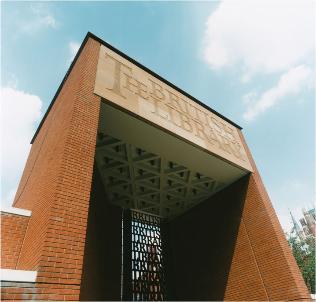
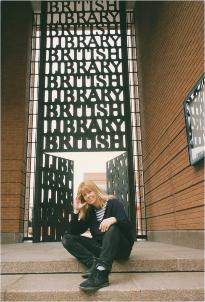
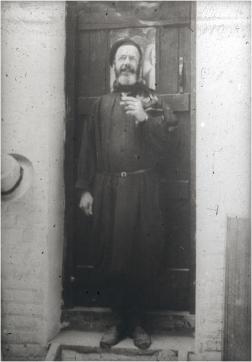
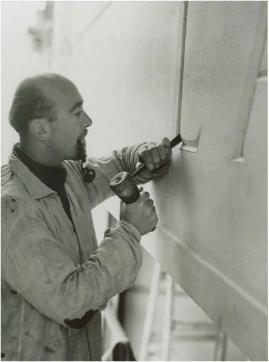
Eric Gill’s first work in Trumpington was the memorial to Captain Francis Percy Campbell Pemberton, who had been killed in action on 19 October 1914. This was commissioned by the Pemberton family and placed in the Parish Church in 1915. Lida commented that this plaque is unusual for Eric Gill in having the lettering centred.
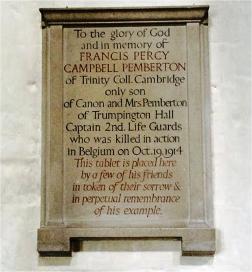
Trumpington War Memorial
Lida explained that Mrs Viola Pemberton (Captain Francis Pemberton’s sister) and her husband, William Wingate, were then responsible for Eric Gill being commissioned in 1919 to design the Trumpington War Memorial. Dr Wingate was on the Parish sub-committee that was formed to choose a suitable memorial. Mrs Pemberton was very influential over the decisions of the sub-committee, writing in 1947 that she and Dr Wingate had to “educate” the local committee to accept Gill’s work. Gill quoted £400 to carve the memorial himself or £100 if the monument was prepared by local masons and he was only responsible for the carving of the lettering and images. The sub-committee agreed that Gill should be commissioned to carry out the entire work. Funds were raised across the Parish, including £200 contributed by the Pemberton family in 1919.
Eric Gill had already been responsible for the design of a number of other war memorials, including those at Briantspuddle, Dorset, and South Harting, Hampshire, which influenced the design of the Trumpington memorial.
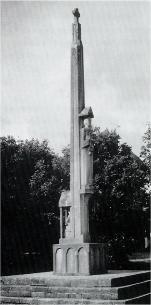

Lida said that the Trumpington War Memorial was commissioned in 1919 and unveiled in 1921. The memorial was built from Portland stone, with a 14.5 foot (4.4 m) cross standing on a 4 foot (1.2 m) square plinth, itself standing on a square base of three steps. It includes a carving of St Michael and the dragon, which Lida said was an intriguing and disturbing image as it has a female slithering dragon with breasts which had mouths (no longer identifiable) and also a female-looking portrayal of St Michael.

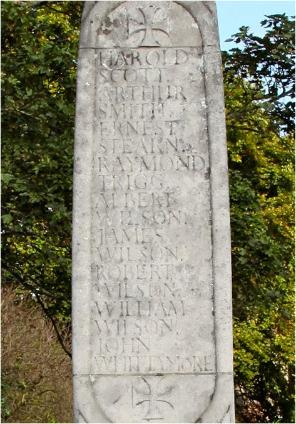
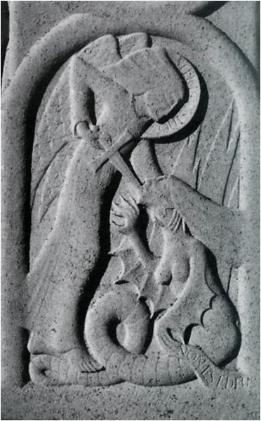
The memorial was unveiled on 11 December 1921 by the Lord Lieutenant of Cambridgeshire, C.R.W. Adeane. Lida commented that the memorial booklet shows it standing lonely on Cross Hill.
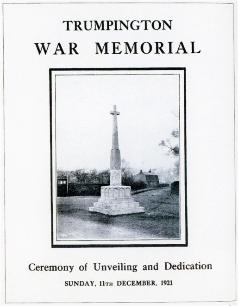
In 1947, David Kindersley was asked to produce a design for the memorial to include the names of those who had died in the Second World War. David’s drawing was done on 9 October 1947, with the names centred within the outer panels on the plinth. Lida said that Mrs Viola Pemberton wrote to David on 12 October 1947 to say that Eric Gill (who Mrs Pemberton said had stayed with the Pembertons in Trumpington Hall on several occasions) was very insistent that all of the names should be set to the left but David stuck to his decision and kept the names as he had originally intended. The dates 1939 and 1945 were set high in the centre panel in the original design and David did change this when it was raised in Mrs Pemberton’s letter. Mrs Pemberton said to David that “Your handwriting is so like Eric Gill’s it gave me quite a start to see it when your design and letter was shown me!”. David was paid £27 10s 0p for the additional inscription. On 12 November 1947, Colonel E. Saville Peck, of Friarswood, Long Road, wrote to David that “The unveiling ceremony took place on Sunday in beautiful weather in the presence of several hundred people. I had the honour of unveiling the new inscription and mentioned that you, an old pupil of Eric Gill, had added the eight names.”
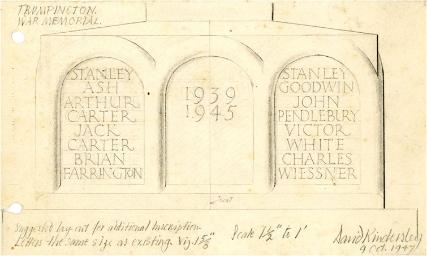
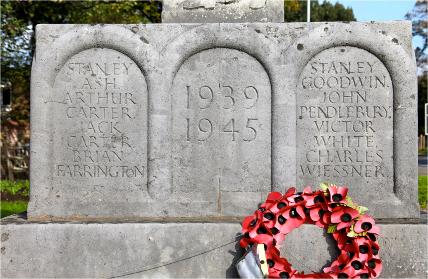
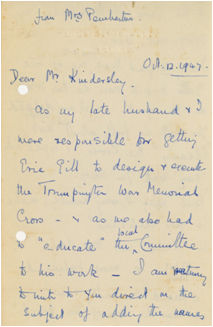
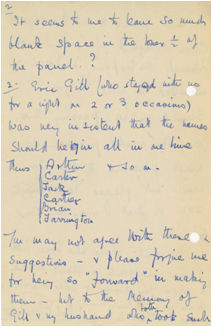
Lida said that there were endless discussions in 1950 about cleaning the memorial. Colonel Peck wrote to David about the cleaning, saying that he had been informed that the Women’s Institute would undertake the work “under the supervision of Mr Kindersley”. The Honorary Secretary of the Women’s Institute was of course Mrs Viola Pemberton. David was adamant that only water and a washing up brush should be used.
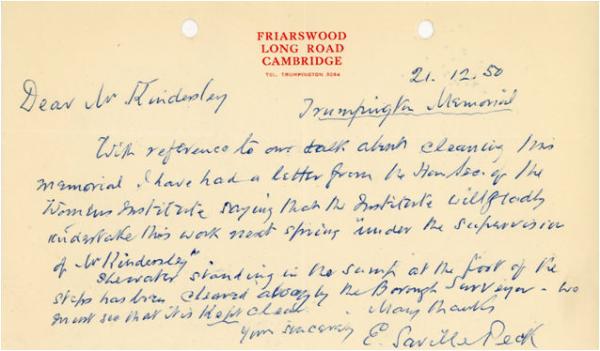
One of the panels on the memorial represents a soldier. Lida said that this had first been drawn by David Jones and then engraved and carved by Eric Gill, both in 1921. The panel showed the effect of cleaning in 1950.
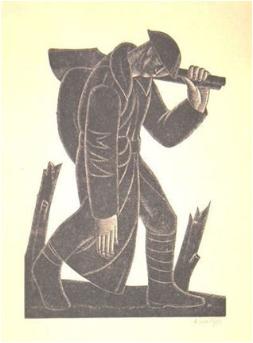
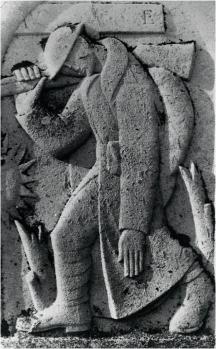
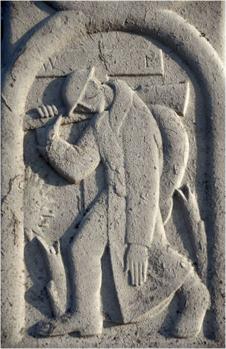
David was consulted again in 1952, this time by the vicar, Rev. T. Young, who inquired about the cleaning of the memorial, writing “I am not one who likes everything to have a new look, I am not convinced that the shaft and cross require any attention”. David wrote back and advised Rev. Young to leave well alone and that he felt it would be a mistake to clean the monument as it would cause further damage to the delicate carving. He wrote “You probably realise that I am not a person in favour of keeping monuments of this kind in this climate clean. I like them as they are and more particularly so perhaps in this case because it seems to me, apart from being a War Memorial, that it is also a Village Cross excepted unobtrusive and symbolic for those who wish to discover it.”
In 2010, Lida was asked by Cambridge City Council whether the memorial should be cleaned and advised to leave it alone, that the memorial was sound, had done its weathering and was in good condition.
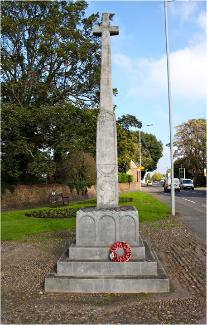
Other work in Trumpington
Lida then briefly discussed a number of other projects carried out in Trumpington by the Workshop. She started with the example of a Pemberton family memorial in Trumpington Churchyard Extension, where the names of Annie Mason (who was a family servant) and then Viola Pemberton had been added.
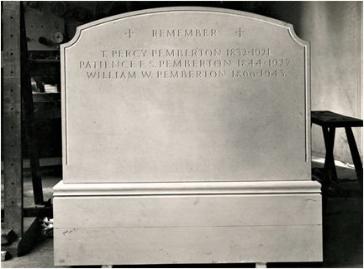

Lida said that slate was a wonderful material to cut, although it was necessary to wash out the dust and then add an off-white paint to the cut which would last about 20 years. They used slate from the British Isles, including from Wales and the Lake District. There were a number of slate plaques on the walls of Trumpington Churchyard. Lida explained that if asked to produce a memorial, they would normally make a drawing to be approved by the client. The memorial would then be fixed in place. When a second name was added, this would be done in situ.
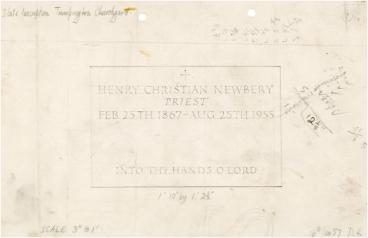
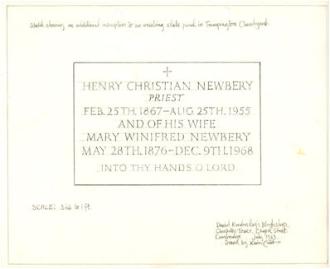
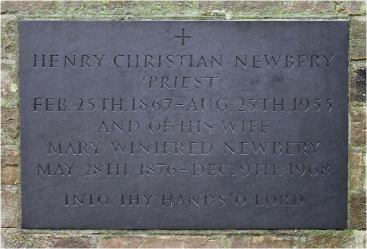
Lida showed a number of examples of designs and final memorials for Trumpington Churchyard. She mentioned the opportunities to use different styles of lettering, flourishes, sans serif, etc.
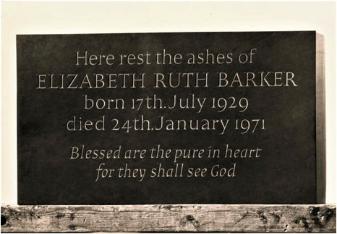
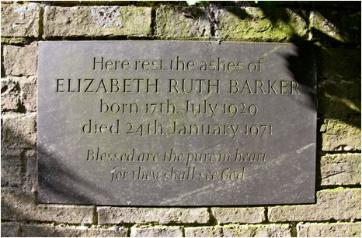
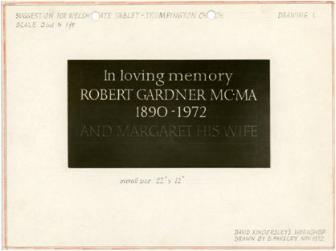
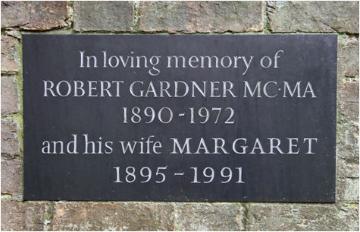
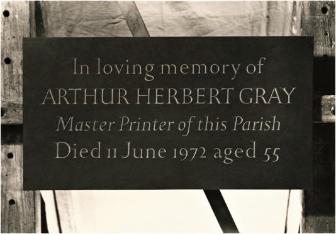
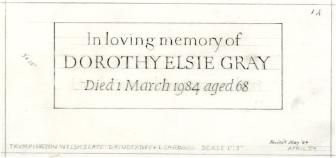
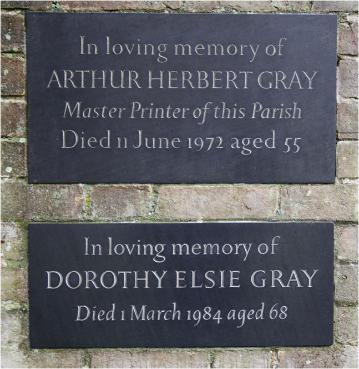
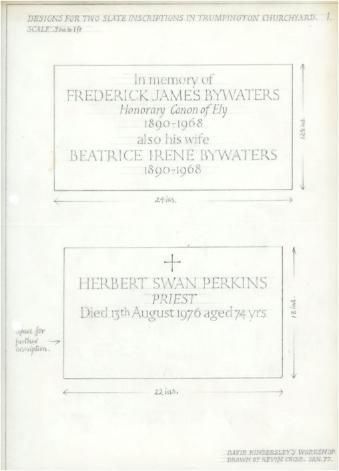

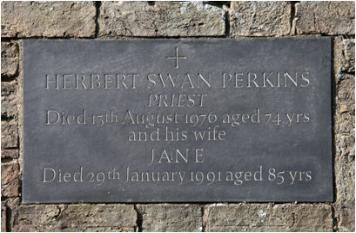
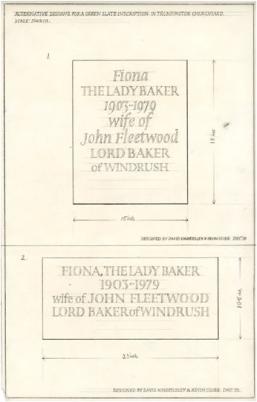
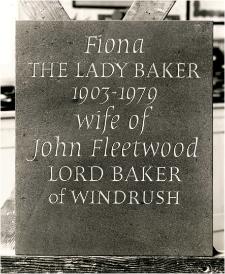
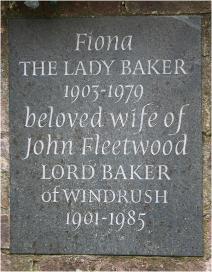
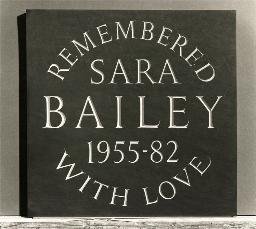
Lida talked about the memorial to Sir George Darwin and Maud du Puy and their daughter, Gwendolen Mary Raverat, in Trumpington Churchyard Extension. She explained that the original York stone memorial in 1950 had lead letters which David Kindersley removed. The memorial was rebuilt and the inscription was recut with additional details. In 1958, after the death of Gwen Raverat, it was decided to remove the memorial and replaced it with a flat slate ledger stone on a Portland stone plinth, with the fuller inscription.

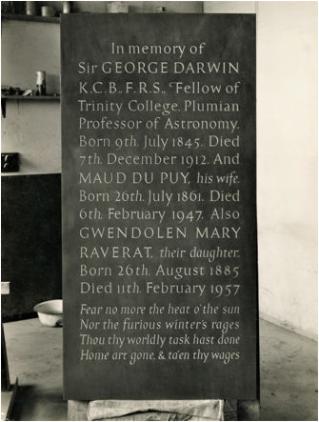
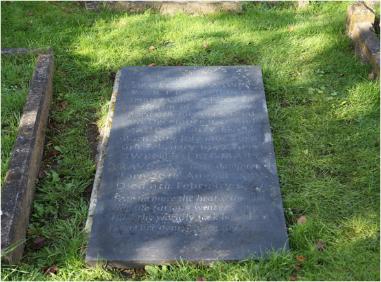
She gave another example of a Portland stone memorial placed against a wall in Trumpington Churchyard, that of Reginald George Smith. Portland stone takes on colour from its environment, such as green when placed under trees.
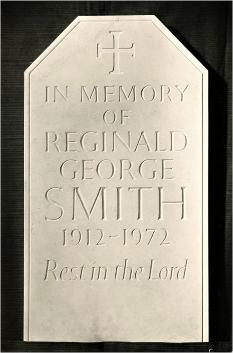
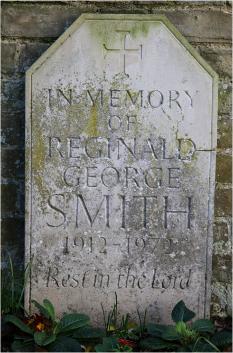
Other examples
Lida gave other examples of the work of the studio and David Kindersley’s inspiration. In 1950, David was horrified by the design of new street signs and offered to design a new typeface for Cambridge Council. When he asked the Council to pay £150 for the design, they were not willing to do so. David then offered it to the Ministry of Transport, which accepted the design and paid for it. Ironically, it was then used in Cambridge! In 1981, he designed the lettering on the exterior of the Cambridge University Press building (now demolished).
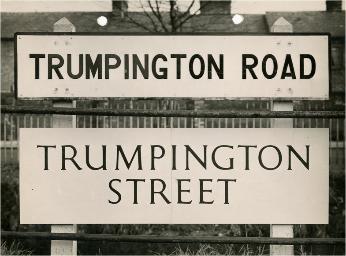
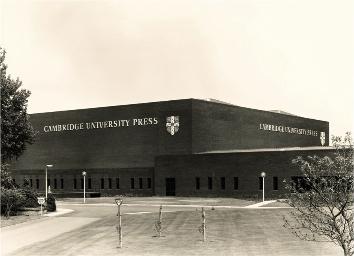
In 1960, David Kindersley created the maps for the Cambridge American Cemetery at Madingley, with the help of glues developed by Norman de Bruyne.
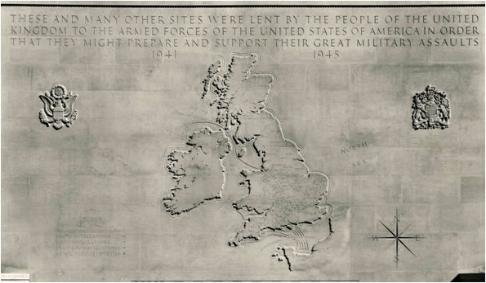
Lida also showed examples of the extensive work done by the Cardozo Kindersley Workshop at Addenbrooke’s Hospital. These include a plaque in Outpatients commemorating the opening of the hospital by the Queen in 1962; a plaque commemorating the opening of the second phase of the hospital in 1973; a plaque concerning the inauguration of the Clinical School in 1976; a plaque commemorating Francis Pemberton near the entrance to the Frank Lee Centre; a commemoration of the Clinical School in 1996; and a memorial to David Kindersley.
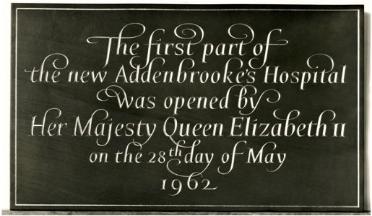


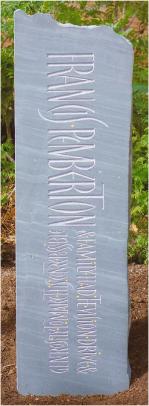
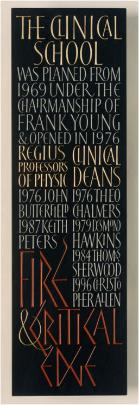
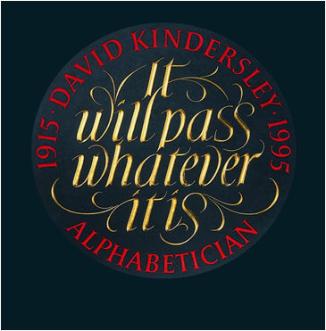
After showing a number of other Cambridge examples, Lida closed her presentation by saying that the Workshop was keeping up its long tradition, including taking on a new apprentice each year. There were currently 6 cutters and 3 others in the Workshop.
